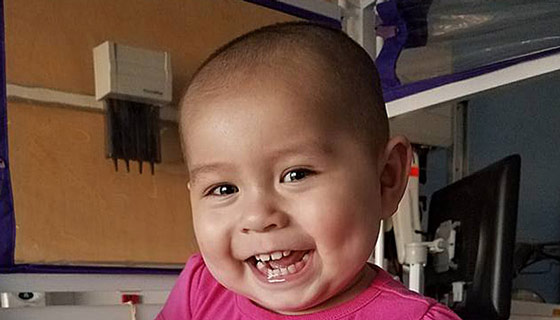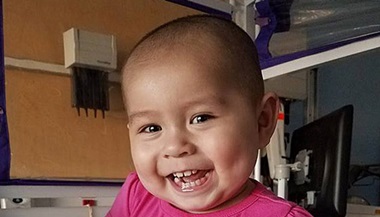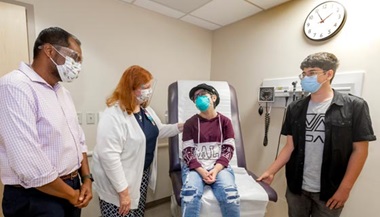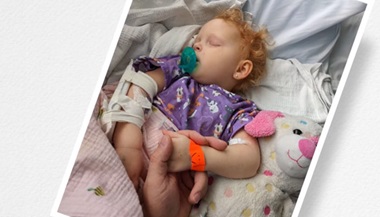Patient Story
Acute Myeloid Leukemia: Susana's Story
Patient Story Highlights
- Johns Hopkins All Children’s Hospital was an early adopter of the half-matched blood marrow transplant technique, which is helping patients like Susana.
- Susana had acute myeloid leukemia, an aggressive form of cancer, which progresses rapidly if it is not treated appropriately.
- Three years after her procedure, Susana can be considered cured. “It’s very rare for leukemia to come back this late after a bone marrow transplant,” Oshrine says.
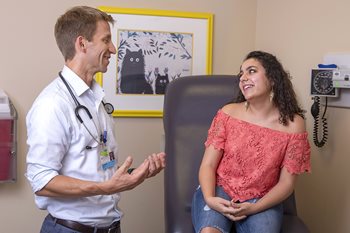
Susana remembers a nurse smiling at her and saying it was OK to keep on sleeping.
Three months earlier, the 14-year-old couldn’t eat because of a bad throat infection. Three different urgent care physicians misdiagnosed her with mononucleosis and prescribed antibiotics that actually left her feeling pretty good. Fortunately, Susana’s mother insisted on a visit to her pediatrician, who sent her to Johns Hopkins All Children’s Hospital, where she was diagnosed accurately.
Susana had acute myeloid leukemia, an aggressive form of cancer, which progresses rapidly if it is not treated appropriately. She was immediately admitted and began high-dose chemotherapy. Genetic testing indicated a very high risk of relapse if she was treated only with chemotherapy, however, so it was clear she would need something more.
Her nurse’s reassuring words accompanied a bone marrow transplant performed at Johns Hopkins All Children’s, using an advanced technique developed at Johns Hopkins in Baltimore, which allowed her mother to be the bone marrow donor.
“All I remember was a nurse showing me the bone marrow and shooting it up. They put it in like a blood transfusion,” Susana says. “When I woke up, it was done, and I had had the transplant.”
Half-Matched Donor? No Problem
Until recently, bone marrow transplantation required a donor with almost identical genetic characteristics. A full sibling is usually the best option, followed by a possible match from an unrelated person enrolled in a volunteer donor registry. Many people who urgently needed a transplant could not find a donor quickly. The problem was especially difficult for Hispanic patients like Susana and for African-Americans because those ethnic groups are not well represented in registries of volunteer donors.
Beginning about 10 years ago, researchers at Johns Hopkins Medicine developed and perfected a technique to allow “half-matched” donors—people with only a 50 percent genetic match—to be suitable bone marrow donors.
Normally, even patients with a 100 percent matching donor receive medications to prevent graft versus host disease (GVHD), a common complication of bone marrow transplant in which white blood cells in the donor’s tissue attack the recipient’s body.
“Before, when you use a half-matched donor, the risk of GVHD with standard preventative medicines would be way too high and result in severe GVHD almost all the time,” says Benjamin Oshrine, M.D., who performed Susana’s bone marrow transplant at Johns Hopkins All Children’s.
Johns Hopkins researchers discovered that administering a special chemotherapy called cyclophosphamide at a specific time after the transplant reduces the risk of GVHD dramatically and makes half-matched bone marrow transplantation very safe, with outcomes comparable to a transplant from a perfectly matched donor.
“In terms of the immune protein that we match for, parents are always a half match with their children, so almost all children, unless they are adopted, can have a half-matched donor available in a timely fashion,” Oshrine says. “It literally makes something that would otherwise be impossible relatively straightforward. We can perform an urgent transplant quickly, without worrying about donor availability and timing.”
The half-matched blood marrow transplant technique is increasingly used around the country for both children and adults. Johns Hopkins All Children’s was an early adopter of this new approach.
“Because of our relatively large Hispanic population, we often have a hard time finding well-matched unrelated donors that will be suitable,” Oshrine says. “We started using this technique fairly early after it became readily available for use in pediatrics.”
Large studies of adult transplants show that outcomes for patients who receive a half-matched transplant are almost identical to those with a fully matched donor, either related or unrelated, Oshrine says. There have been fewer pediatric half-matched procedures, but enough to show that outcomes with children also approximate what would be expected with a fully matched donor.
Strength and Healing
To prepare her body for the transplant, Susana went through three months of chemotherapy to kill the cancer.
“Then a week before the transplant, I went into a very intense round of chemotherapy. I barely remember anything from it,” she says. “That was the absolute worst week because that last chemo got rid of all my bone marrow. It was completely gone and it was time to put my mom’s bone marrow in me to start over.”
Oshrine explains that pre-transplant chemotherapy is intended to rid the patient of leukemia, suppress the patient’s immune system so it can accept the donor’s bone marrow cells, and make space in the bone marrow, so the donor’s bone marrow cells can take root and grow.
On the day of the transplant, Susana’s mom had a surgical procedure at Moffitt Cancer Center in Tampa, Florida. Bone marrow was harvested from her hip bones and rushed to her daughter at Johns Hopkins All Children’s in St. Petersburg, where it was infused into Susana’s blood stream.
Susana stayed in the hospital for another month. After two weeks, she got some good news.
“Dr. Oshrine came in through the door, and he was so happy,” Susana says. “He said, ‘95 percent of the bone marrow is your mom’s.’”
Three years after her procedure, Susana can be considered cured. “It’s very rare for leukemia to come back this late after a bone marrow transplant,” Oshrine says.
Going through cancer treatment is not for the faint of heart, and Susana found the strength she needed.
“I think it takes a very strong person to go through this, and you shouldn’t treat people who have cancer like they are a ball of glass,” she says. “Always have faith in God that everything is in His hands."


